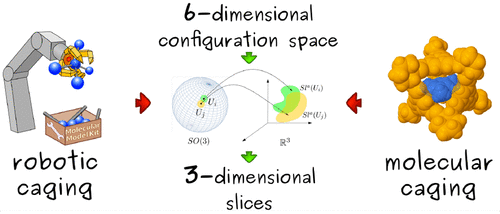当前位置:
X-MOL 学术
›
J. Chem. Inf. Model.
›
论文详情
Our official English website, www.x-mol.net, welcomes your feedback! (Note: you will need to create a separate account there.)
A Robotics-Inspired Screening Algorithm for Molecular Caging Prediction.
Journal of Chemical Information and Modeling ( IF 5.6 ) Pub Date : 2020-03-04 , DOI: 10.1021/acs.jcim.9b00945 Oleksandr Kravchenko 1 , Anastasiia Varava 2 , Florian T Pokorny 2 , Didier Devaurs 3 , Lydia E Kavraki 4 , Danica Kragic 2
Journal of Chemical Information and Modeling ( IF 5.6 ) Pub Date : 2020-03-04 , DOI: 10.1021/acs.jcim.9b00945 Oleksandr Kravchenko 1 , Anastasiia Varava 2 , Florian T Pokorny 2 , Didier Devaurs 3 , Lydia E Kavraki 4 , Danica Kragic 2
Affiliation

|
We define a molecular caging complex as a pair of molecules in which one molecule (the “host” or “cage”) possesses a cavity that can encapsulate the other molecule (the “guest”) and prevent it from escaping. Molecular caging complexes can be useful in applications such as molecular shape sorting, drug delivery, and molecular immobilization in materials science, to name just a few. However, the design and computational discovery of new caging complexes is a challenging task, as it is hard to predict whether one molecule can encapsulate another because their shapes can be quite complex. In this paper, we propose a computational screening method that predicts whether a given pair of molecules form a caging complex. Our method is based on a caging verification algorithm that was designed by our group for applications in robotic manipulation. We tested our algorithm on three pairs of molecules that were previously described in a pioneering work on molecular caging complexes and found that our results are fully consistent with the previously reported ones. Furthermore, we performed a screening experiment on a data set consisting of 46 hosts and four guests and used our algorithm to predict which pairs are likely to form caging complexes. Our method is computationally efficient and can be integrated into a screening pipeline to complement experimental techniques.
中文翻译:

用于分子笼预测的机器人启发式筛选算法。
我们定义了分子笼复合物作为一对分子,其中一个分子(“宿主”或“笼”)拥有一个空腔,该空腔可以封装另一个分子(“来宾”)并阻止其逸出。分子笼络复合物可用于材料科学中的分子形状分类,药物递送和分子固定等应用,仅举几例。但是,新笼形复合物的设计和计算发现是一项艰巨的任务,因为很难预测一个分子是否可以封装另一个分子,因为它们的形状可能非常复杂。在本文中,我们提出了一种计算筛选方法,该方法可预测给定的一对分子是否形成笼罩复合物。我们的方法基于由我们小组针对机器人操纵中的应用而设计的笼式验证算法。我们在三对分子上测试了我们的算法,这些分子先前在分子笼罩复合物的开创性工作中已有描述,发现我们的结果与以前报道的结果完全一致。此外,我们对由46位宿主和4位客人组成的数据集进行了筛选实验,并使用我们的算法来预测哪些对可能形成笼子复合物。我们的方法计算效率高,可以集成到筛选管道中以补充实验技术。我们对由46位宿主和4位客人组成的数据集进行了筛选实验,并使用我们的算法来预测哪些对可能形成笼子复合物。我们的方法计算效率高,可以集成到筛选管道中以补充实验技术。我们对由46位宿主和4位客人组成的数据集进行了筛选实验,并使用我们的算法来预测哪些对可能形成笼子复合物。我们的方法计算效率高,可以集成到筛选管道中以补充实验技术。
更新日期:2020-04-24
中文翻译:

用于分子笼预测的机器人启发式筛选算法。
我们定义了分子笼复合物作为一对分子,其中一个分子(“宿主”或“笼”)拥有一个空腔,该空腔可以封装另一个分子(“来宾”)并阻止其逸出。分子笼络复合物可用于材料科学中的分子形状分类,药物递送和分子固定等应用,仅举几例。但是,新笼形复合物的设计和计算发现是一项艰巨的任务,因为很难预测一个分子是否可以封装另一个分子,因为它们的形状可能非常复杂。在本文中,我们提出了一种计算筛选方法,该方法可预测给定的一对分子是否形成笼罩复合物。我们的方法基于由我们小组针对机器人操纵中的应用而设计的笼式验证算法。我们在三对分子上测试了我们的算法,这些分子先前在分子笼罩复合物的开创性工作中已有描述,发现我们的结果与以前报道的结果完全一致。此外,我们对由46位宿主和4位客人组成的数据集进行了筛选实验,并使用我们的算法来预测哪些对可能形成笼子复合物。我们的方法计算效率高,可以集成到筛选管道中以补充实验技术。我们对由46位宿主和4位客人组成的数据集进行了筛选实验,并使用我们的算法来预测哪些对可能形成笼子复合物。我们的方法计算效率高,可以集成到筛选管道中以补充实验技术。我们对由46位宿主和4位客人组成的数据集进行了筛选实验,并使用我们的算法来预测哪些对可能形成笼子复合物。我们的方法计算效率高,可以集成到筛选管道中以补充实验技术。


























 京公网安备 11010802027423号
京公网安备 11010802027423号